2201LHS Project: English as a Global Language Analysis
VerifiedAdded on 2023/01/23
|14
|3705
|37
Project
AI Summary
This project is a comprehensive analysis of English as a Global Language, specifically examining Australian English. It delves into the sociolinguistic factors influencing the language, including the attitudes towards rural Australian English, lexical analysis, morphological analysis, and the impact of loanwords from Maori. The analysis incorporates transcribed samples from various sources, such as video clips and news articles, to illustrate the concepts discussed. The project explores the challenges and complexities of English as a lingua franca in the Australian context, considering the variations in functions and geographical differences, particularly in relation to indigenous languages like Maori. The project also investigates the role of ICT and the impact of language on cultural understanding and communication, emphasizing the importance of effective teaching strategies and addressing the attitudes of both teachers and learners. The study aims to demonstrate the diverse characteristics of the English language and its evolution as a global communication tool.

2201LHS English as a Global Language
English as Lingua Franca
Name:
Institutional Affiliation
Author Note:
English as Lingua Franca
Name:
Institutional Affiliation
Author Note:
Paraphrase This Document
Need a fresh take? Get an instant paraphrase of this document with our AI Paraphraser

2201LHS English as a Global Language
Contents
Introduction...........................................................................................................................................3
Sociolinguistic (Rural verse standard Australian English).....................................................................3
Shapping the attitude.........................................................................................................................4
Nature of Language and the role of ICT............................................................................................5
Lexical Analysis....................................................................................................................................7
Morphological Analysis (Studying words)........................................................................................8
Loan-words from Maori....................................................................................................................9
Conclusion.............................................................................................................................................9
APPENDIX 1......................................................................................................................................11
Video Clip 9 Adopted from (McEvoy, 2015)..................................................................................11
APPENDIX 2......................................................................................................................................11
Australian Accent Speech (adopted from; Hunter, 2019)................................................................11
APPENDIX 3......................................................................................................................................12
News clip (Adopted from; Clennell, 2008)......................................................................................12
REFERENCES....................................................................................................................................13
Contents
Introduction...........................................................................................................................................3
Sociolinguistic (Rural verse standard Australian English).....................................................................3
Shapping the attitude.........................................................................................................................4
Nature of Language and the role of ICT............................................................................................5
Lexical Analysis....................................................................................................................................7
Morphological Analysis (Studying words)........................................................................................8
Loan-words from Maori....................................................................................................................9
Conclusion.............................................................................................................................................9
APPENDIX 1......................................................................................................................................11
Video Clip 9 Adopted from (McEvoy, 2015)..................................................................................11
APPENDIX 2......................................................................................................................................11
Australian Accent Speech (adopted from; Hunter, 2019)................................................................11
APPENDIX 3......................................................................................................................................12
News clip (Adopted from; Clennell, 2008)......................................................................................12
REFERENCES....................................................................................................................................13

2201LHS English as a Global Language
Introduction
English as Lingua Franca refers to a language spoken by non-natives. Global English have
variations in functions and geographical differences. In Australia, English is a first language
for many but it is also a second language for natives like the New Zealand Maori’s. Van de
Grifit, Paran, Jansen, & Bloemert (2019) identify pedagogical challenges of understanding
foreign language (FL). Caused by historical factors such as colonialism, EFL accommodates
a cross cultural perspective. Appendix 1 shows an example of the historical influence on
language which affects EFL material. Although this promotes language unity, it also raises
questions about its adoption as a common language for business, academic and official use.
The indigenous people’s language of the distinct community in the region, the Maori
identifies inherent difficulties of speech and written English. EFL challenges include teaching
strategies, student attitude, cross cultural compatibility and effective communication. This
analysis captures the sociolinguistic factors of EFL within the Australian contexts and the
lexical ambiguity that could arise in the embedded in the language. Understanding the native
learner’s attitude investigates the importance of EFL in the global perspective.
Sociolinguistic (Rural verse standard Australian English)
Literary theory is the systematic approach used by students when approaching literature
material (Kirkpatrick, 2014). Students try to derive meaning from written and spoken
language. In literature the meaning of a text becomes correct depending on the language. The
non-standard English forms motivate the learners to communicate. Structuralism in literature
acknowledges the role of human culture in the formation of language. It defines belief
systems hence the relationship with language and its variations (Hultgren, 2016). An analysis
of spoken language or parole highlights sound patterns that differ in speech acts and language
types. In the Maori context some names are common to English. For example EFL in New
Introduction
English as Lingua Franca refers to a language spoken by non-natives. Global English have
variations in functions and geographical differences. In Australia, English is a first language
for many but it is also a second language for natives like the New Zealand Maori’s. Van de
Grifit, Paran, Jansen, & Bloemert (2019) identify pedagogical challenges of understanding
foreign language (FL). Caused by historical factors such as colonialism, EFL accommodates
a cross cultural perspective. Appendix 1 shows an example of the historical influence on
language which affects EFL material. Although this promotes language unity, it also raises
questions about its adoption as a common language for business, academic and official use.
The indigenous people’s language of the distinct community in the region, the Maori
identifies inherent difficulties of speech and written English. EFL challenges include teaching
strategies, student attitude, cross cultural compatibility and effective communication. This
analysis captures the sociolinguistic factors of EFL within the Australian contexts and the
lexical ambiguity that could arise in the embedded in the language. Understanding the native
learner’s attitude investigates the importance of EFL in the global perspective.
Sociolinguistic (Rural verse standard Australian English)
Literary theory is the systematic approach used by students when approaching literature
material (Kirkpatrick, 2014). Students try to derive meaning from written and spoken
language. In literature the meaning of a text becomes correct depending on the language. The
non-standard English forms motivate the learners to communicate. Structuralism in literature
acknowledges the role of human culture in the formation of language. It defines belief
systems hence the relationship with language and its variations (Hultgren, 2016). An analysis
of spoken language or parole highlights sound patterns that differ in speech acts and language
types. In the Maori context some names are common to English. For example EFL in New
⊘ This is a preview!⊘
Do you want full access?
Subscribe today to unlock all pages.

Trusted by 1+ million students worldwide

2201LHS English as a Global Language
Zealand acknowledges tribal names such as Kiwi, and Maori. Manhire (2018) identifies
Australian diveeristy through phrases that are common in the language including “Te
Karere”. Diversity in a multilingual envioronment requires effective teaching and
communication styles. Language context variables vary therefore linguitics tools support the
pragmatic linguitics. The use of direct strategies is effective in minimizing errors in English.
Effective communication styles enhance a peacful coexitance for the learning environment to
thrive. This involves Strategies which evaluate the native learner’s ideology through a cross
cultural perspecive of the pragmatics (Lenchuk & Ahmed, 2019).
Shapping the attitude
The meaning of language also changes according to the structural paradigm. Walkinshaw
(2016) identifies the ambiguity of social action in EFL to indicate diversions in the
conveyance of meaning. Although focusing on the informal context reinforces the role of
utterances, the description of teasing as a social action is phenomenal. Learners of Australian
English find New Zealanders language because the country has a dual cultural approach
(Manhire, 2018). In Maori EFL language communication needs a pragmatic context. The
construction of language through different syntactic categories shapes the semantic value of a
language. This means that spoken language features such as pauses, coughs and gestures have
meaning. Written and transcribed data displays changes in vocal quality. The usefulness of
‘sound bites’ means the encoding brings out the contextual elements. Transcribing the spoken
data brings out the language attributes. Both the teacher and learner attitude towards the
mother tongue is critical (Marasigan, Hajan, & Castillo, 2019, p, 231). The table below
highlights critical attributes for the learners and the teacher for the best outcome in a learning
process.
Personal Characteristics Learning activity
Zealand acknowledges tribal names such as Kiwi, and Maori. Manhire (2018) identifies
Australian diveeristy through phrases that are common in the language including “Te
Karere”. Diversity in a multilingual envioronment requires effective teaching and
communication styles. Language context variables vary therefore linguitics tools support the
pragmatic linguitics. The use of direct strategies is effective in minimizing errors in English.
Effective communication styles enhance a peacful coexitance for the learning environment to
thrive. This involves Strategies which evaluate the native learner’s ideology through a cross
cultural perspecive of the pragmatics (Lenchuk & Ahmed, 2019).
Shapping the attitude
The meaning of language also changes according to the structural paradigm. Walkinshaw
(2016) identifies the ambiguity of social action in EFL to indicate diversions in the
conveyance of meaning. Although focusing on the informal context reinforces the role of
utterances, the description of teasing as a social action is phenomenal. Learners of Australian
English find New Zealanders language because the country has a dual cultural approach
(Manhire, 2018). In Maori EFL language communication needs a pragmatic context. The
construction of language through different syntactic categories shapes the semantic value of a
language. This means that spoken language features such as pauses, coughs and gestures have
meaning. Written and transcribed data displays changes in vocal quality. The usefulness of
‘sound bites’ means the encoding brings out the contextual elements. Transcribing the spoken
data brings out the language attributes. Both the teacher and learner attitude towards the
mother tongue is critical (Marasigan, Hajan, & Castillo, 2019, p, 231). The table below
highlights critical attributes for the learners and the teacher for the best outcome in a learning
process.
Personal Characteristics Learning activity
Paraphrase This Document
Need a fresh take? Get an instant paraphrase of this document with our AI Paraphraser
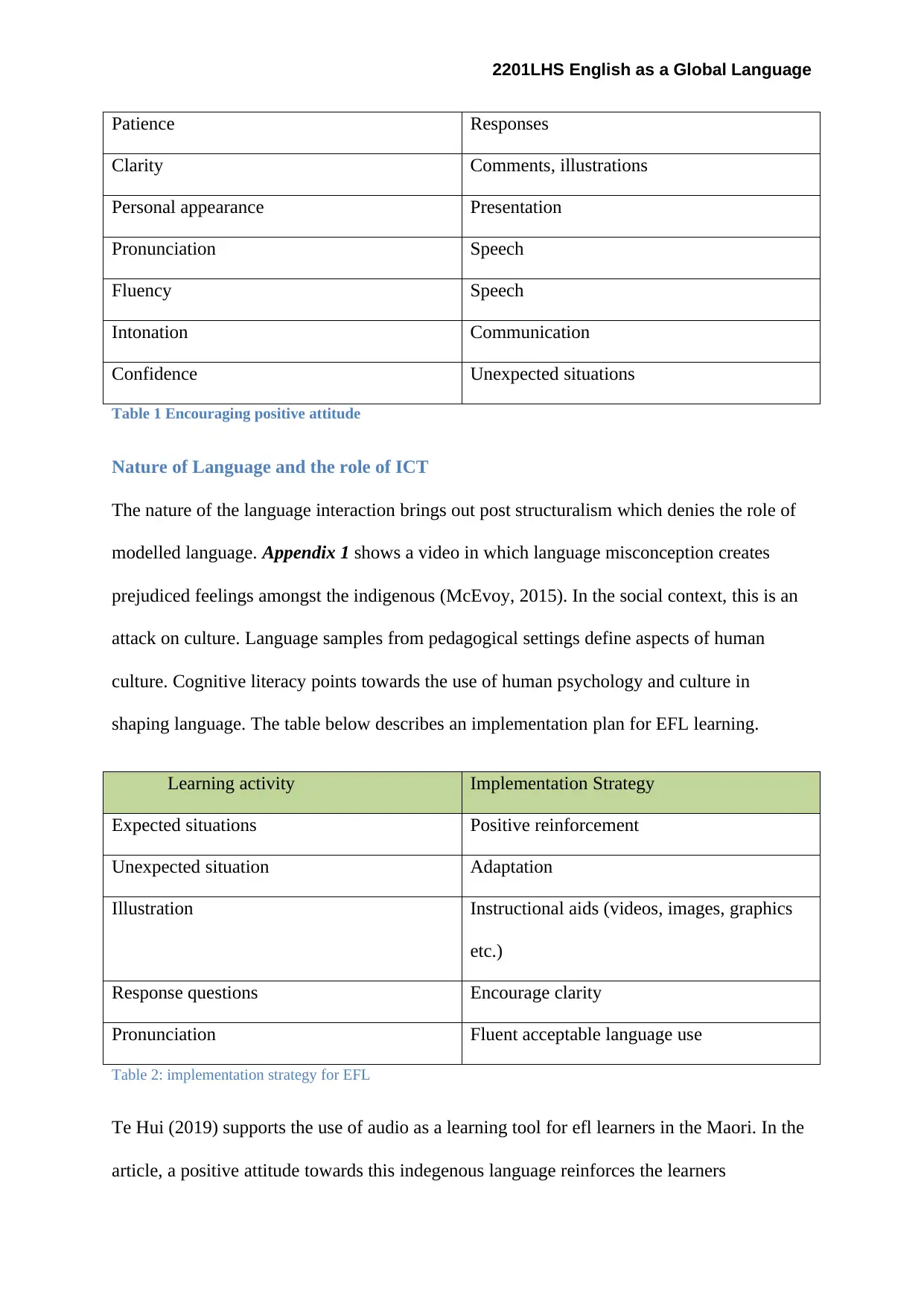
2201LHS English as a Global Language
Patience Responses
Clarity Comments, illustrations
Personal appearance Presentation
Pronunciation Speech
Fluency Speech
Intonation Communication
Confidence Unexpected situations
Table 1 Encouraging positive attitude
Nature of Language and the role of ICT
The nature of the language interaction brings out post structuralism which denies the role of
modelled language. Appendix 1 shows a video in which language misconception creates
prejudiced feelings amongst the indigenous (McEvoy, 2015). In the social context, this is an
attack on culture. Language samples from pedagogical settings define aspects of human
culture. Cognitive literacy points towards the use of human psychology and culture in
shaping language. The table below describes an implementation plan for EFL learning.
Learning activity Implementation Strategy
Expected situations Positive reinforcement
Unexpected situation Adaptation
Illustration Instructional aids (videos, images, graphics
etc.)
Response questions Encourage clarity
Pronunciation Fluent acceptable language use
Table 2: implementation strategy for EFL
Te Hui (2019) supports the use of audio as a learning tool for efl learners in the Maori. In the
article, a positive attitude towards this indegenous language reinforces the learners
Patience Responses
Clarity Comments, illustrations
Personal appearance Presentation
Pronunciation Speech
Fluency Speech
Intonation Communication
Confidence Unexpected situations
Table 1 Encouraging positive attitude
Nature of Language and the role of ICT
The nature of the language interaction brings out post structuralism which denies the role of
modelled language. Appendix 1 shows a video in which language misconception creates
prejudiced feelings amongst the indigenous (McEvoy, 2015). In the social context, this is an
attack on culture. Language samples from pedagogical settings define aspects of human
culture. Cognitive literacy points towards the use of human psychology and culture in
shaping language. The table below describes an implementation plan for EFL learning.
Learning activity Implementation Strategy
Expected situations Positive reinforcement
Unexpected situation Adaptation
Illustration Instructional aids (videos, images, graphics
etc.)
Response questions Encourage clarity
Pronunciation Fluent acceptable language use
Table 2: implementation strategy for EFL
Te Hui (2019) supports the use of audio as a learning tool for efl learners in the Maori. In the
article, a positive attitude towards this indegenous language reinforces the learners
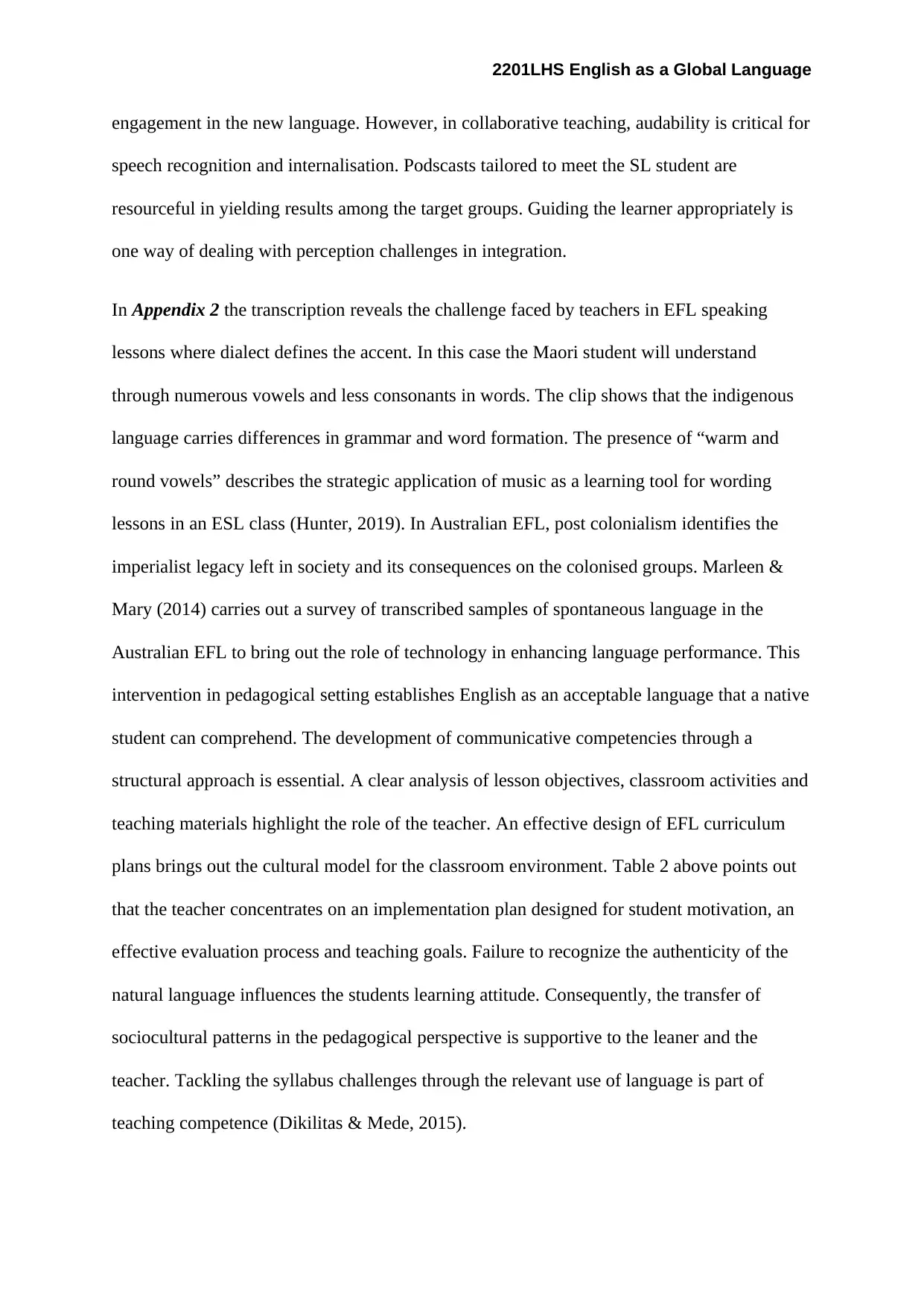
2201LHS English as a Global Language
engagement in the new language. However, in collaborative teaching, audability is critical for
speech recognition and internalisation. Podscasts tailored to meet the SL student are
resourceful in yielding results among the target groups. Guiding the learner appropriately is
one way of dealing with perception challenges in integration.
In Appendix 2 the transcription reveals the challenge faced by teachers in EFL speaking
lessons where dialect defines the accent. In this case the Maori student will understand
through numerous vowels and less consonants in words. The clip shows that the indigenous
language carries differences in grammar and word formation. The presence of “warm and
round vowels” describes the strategic application of music as a learning tool for wording
lessons in an ESL class (Hunter, 2019). In Australian EFL, post colonialism identifies the
imperialist legacy left in society and its consequences on the colonised groups. Marleen &
Mary (2014) carries out a survey of transcribed samples of spontaneous language in the
Australian EFL to bring out the role of technology in enhancing language performance. This
intervention in pedagogical setting establishes English as an acceptable language that a native
student can comprehend. The development of communicative competencies through a
structural approach is essential. A clear analysis of lesson objectives, classroom activities and
teaching materials highlight the role of the teacher. An effective design of EFL curriculum
plans brings out the cultural model for the classroom environment. Table 2 above points out
that the teacher concentrates on an implementation plan designed for student motivation, an
effective evaluation process and teaching goals. Failure to recognize the authenticity of the
natural language influences the students learning attitude. Consequently, the transfer of
sociocultural patterns in the pedagogical perspective is supportive to the leaner and the
teacher. Tackling the syllabus challenges through the relevant use of language is part of
teaching competence (Dikilitas & Mede, 2015).
engagement in the new language. However, in collaborative teaching, audability is critical for
speech recognition and internalisation. Podscasts tailored to meet the SL student are
resourceful in yielding results among the target groups. Guiding the learner appropriately is
one way of dealing with perception challenges in integration.
In Appendix 2 the transcription reveals the challenge faced by teachers in EFL speaking
lessons where dialect defines the accent. In this case the Maori student will understand
through numerous vowels and less consonants in words. The clip shows that the indigenous
language carries differences in grammar and word formation. The presence of “warm and
round vowels” describes the strategic application of music as a learning tool for wording
lessons in an ESL class (Hunter, 2019). In Australian EFL, post colonialism identifies the
imperialist legacy left in society and its consequences on the colonised groups. Marleen &
Mary (2014) carries out a survey of transcribed samples of spontaneous language in the
Australian EFL to bring out the role of technology in enhancing language performance. This
intervention in pedagogical setting establishes English as an acceptable language that a native
student can comprehend. The development of communicative competencies through a
structural approach is essential. A clear analysis of lesson objectives, classroom activities and
teaching materials highlight the role of the teacher. An effective design of EFL curriculum
plans brings out the cultural model for the classroom environment. Table 2 above points out
that the teacher concentrates on an implementation plan designed for student motivation, an
effective evaluation process and teaching goals. Failure to recognize the authenticity of the
natural language influences the students learning attitude. Consequently, the transfer of
sociocultural patterns in the pedagogical perspective is supportive to the leaner and the
teacher. Tackling the syllabus challenges through the relevant use of language is part of
teaching competence (Dikilitas & Mede, 2015).
⊘ This is a preview!⊘
Do you want full access?
Subscribe today to unlock all pages.

Trusted by 1+ million students worldwide
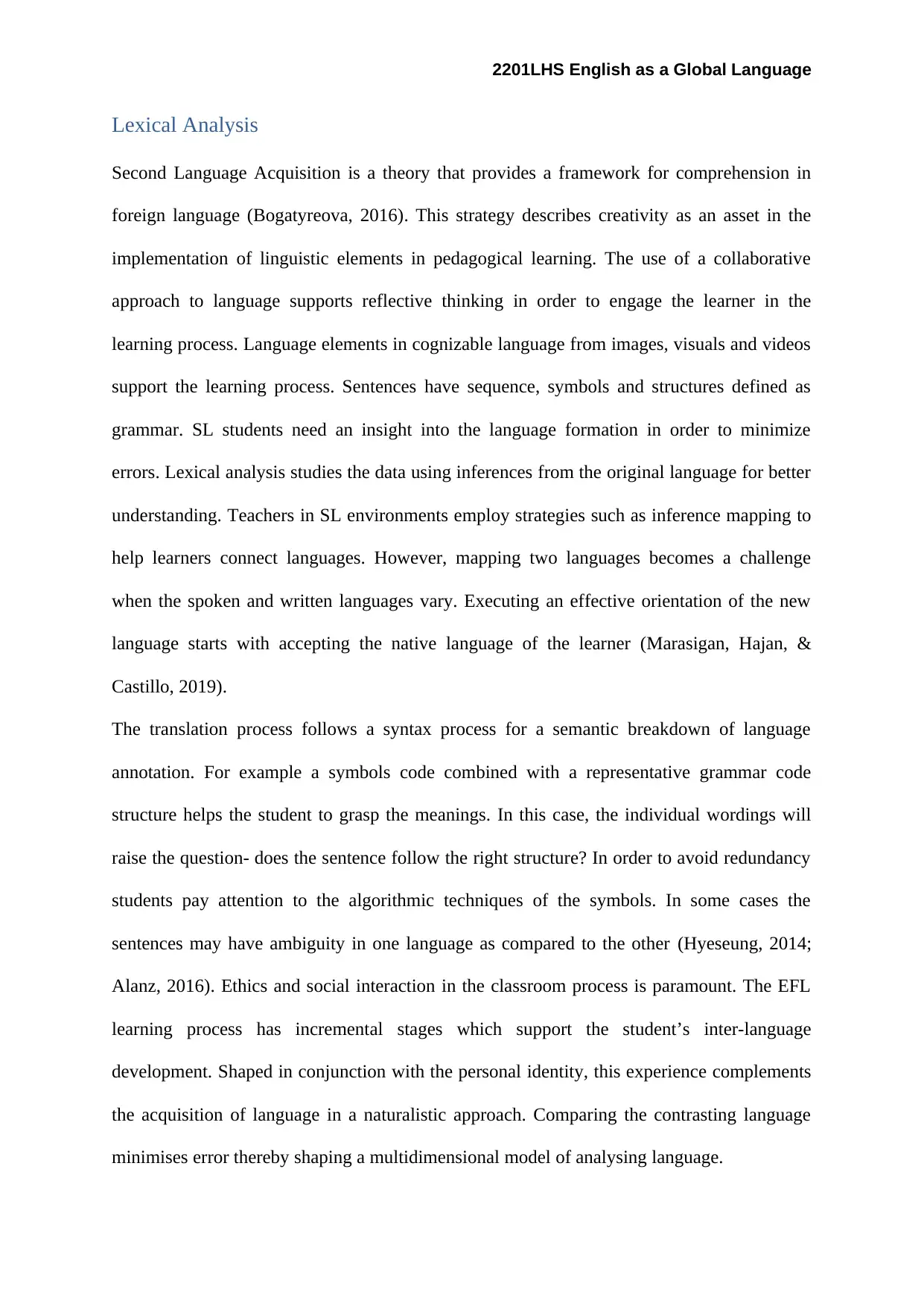
2201LHS English as a Global Language
Lexical Analysis
Second Language Acquisition is a theory that provides a framework for comprehension in
foreign language (Bogatyreova, 2016). This strategy describes creativity as an asset in the
implementation of linguistic elements in pedagogical learning. The use of a collaborative
approach to language supports reflective thinking in order to engage the learner in the
learning process. Language elements in cognizable language from images, visuals and videos
support the learning process. Sentences have sequence, symbols and structures defined as
grammar. SL students need an insight into the language formation in order to minimize
errors. Lexical analysis studies the data using inferences from the original language for better
understanding. Teachers in SL environments employ strategies such as inference mapping to
help learners connect languages. However, mapping two languages becomes a challenge
when the spoken and written languages vary. Executing an effective orientation of the new
language starts with accepting the native language of the learner (Marasigan, Hajan, &
Castillo, 2019).
The translation process follows a syntax process for a semantic breakdown of language
annotation. For example a symbols code combined with a representative grammar code
structure helps the student to grasp the meanings. In this case, the individual wordings will
raise the question- does the sentence follow the right structure? In order to avoid redundancy
students pay attention to the algorithmic techniques of the symbols. In some cases the
sentences may have ambiguity in one language as compared to the other (Hyeseung, 2014;
Alanz, 2016). Ethics and social interaction in the classroom process is paramount. The EFL
learning process has incremental stages which support the student’s inter-language
development. Shaped in conjunction with the personal identity, this experience complements
the acquisition of language in a naturalistic approach. Comparing the contrasting language
minimises error thereby shaping a multidimensional model of analysing language.
Lexical Analysis
Second Language Acquisition is a theory that provides a framework for comprehension in
foreign language (Bogatyreova, 2016). This strategy describes creativity as an asset in the
implementation of linguistic elements in pedagogical learning. The use of a collaborative
approach to language supports reflective thinking in order to engage the learner in the
learning process. Language elements in cognizable language from images, visuals and videos
support the learning process. Sentences have sequence, symbols and structures defined as
grammar. SL students need an insight into the language formation in order to minimize
errors. Lexical analysis studies the data using inferences from the original language for better
understanding. Teachers in SL environments employ strategies such as inference mapping to
help learners connect languages. However, mapping two languages becomes a challenge
when the spoken and written languages vary. Executing an effective orientation of the new
language starts with accepting the native language of the learner (Marasigan, Hajan, &
Castillo, 2019).
The translation process follows a syntax process for a semantic breakdown of language
annotation. For example a symbols code combined with a representative grammar code
structure helps the student to grasp the meanings. In this case, the individual wordings will
raise the question- does the sentence follow the right structure? In order to avoid redundancy
students pay attention to the algorithmic techniques of the symbols. In some cases the
sentences may have ambiguity in one language as compared to the other (Hyeseung, 2014;
Alanz, 2016). Ethics and social interaction in the classroom process is paramount. The EFL
learning process has incremental stages which support the student’s inter-language
development. Shaped in conjunction with the personal identity, this experience complements
the acquisition of language in a naturalistic approach. Comparing the contrasting language
minimises error thereby shaping a multidimensional model of analysing language.
Paraphrase This Document
Need a fresh take? Get an instant paraphrase of this document with our AI Paraphraser

2201LHS English as a Global Language
Morphological Analysis (Studying words)
EFL looks at the relationship between words in order to ascertain its structure. For example,
in a sentence the prefixes, and root words are critical. The parts of speech are as critical as the
intonation and morphemes. In the nonstandard transcription of the Maori speech, expressions
in form of noises symbolising an agreement have standard annotations. When words borrow
from the indigenous in order to make meaning, EFL becomes multilingual (Manhire, 2018).
For example contractions for words such as, ‘bout’ and biscuits as bikkies also bring out word
fragments and the use of colloquialism in language. This explains why cousin becomes
‘cuzzy’ and ‘fella’ for fellow. Additional words in language create differences in meaning. Some
words have multiple morphemes hence the text elements have transcriptions that highlight utterance
words such as….translating the vocalized texts and non-vocalised pauses in incidental noises reveals
the hidden elements of speech. Natural language takes a different tone from learnt lingo because of
sentence segments. Parts of speech such as nouns, pronouns, and verbs may change from Maori to
English. For example, important words in Maori include the function words, namely “te, i, ki,
a, mā, ō” which highlight the connection between clauses in a sentence (Te Kete Ipurangi,
2019). Cultural awareness is important in the study of language because it cultivates the learners
attitude in order to encourage tolerance (Van de Grifit, Paran, Jansen, & Bloemert, 2019).
In Appendix 2 the transcription identifies grammatical aspects of language showing the distribution of
morphology into small units. In this transcription, the Australian accent has vowels and consonants
that may sound different depending on the person making the sound. For example, a native may
pronounce the /i/ sound differently from its usual use in like, right or live into its sound in ‘oi’ in oil.
An analysis of the lexicology brings out the evidence of language variations between Standard
English and EFL (Hartmann, 2016). The bilingual properties of language trigger the need for quality
in the design and conceptuialization of the interlingual properties. Teachers use terminlogy that
resembles the first language in order to activate learning through the stored language.
Morphological Analysis (Studying words)
EFL looks at the relationship between words in order to ascertain its structure. For example,
in a sentence the prefixes, and root words are critical. The parts of speech are as critical as the
intonation and morphemes. In the nonstandard transcription of the Maori speech, expressions
in form of noises symbolising an agreement have standard annotations. When words borrow
from the indigenous in order to make meaning, EFL becomes multilingual (Manhire, 2018).
For example contractions for words such as, ‘bout’ and biscuits as bikkies also bring out word
fragments and the use of colloquialism in language. This explains why cousin becomes
‘cuzzy’ and ‘fella’ for fellow. Additional words in language create differences in meaning. Some
words have multiple morphemes hence the text elements have transcriptions that highlight utterance
words such as….translating the vocalized texts and non-vocalised pauses in incidental noises reveals
the hidden elements of speech. Natural language takes a different tone from learnt lingo because of
sentence segments. Parts of speech such as nouns, pronouns, and verbs may change from Maori to
English. For example, important words in Maori include the function words, namely “te, i, ki,
a, mā, ō” which highlight the connection between clauses in a sentence (Te Kete Ipurangi,
2019). Cultural awareness is important in the study of language because it cultivates the learners
attitude in order to encourage tolerance (Van de Grifit, Paran, Jansen, & Bloemert, 2019).
In Appendix 2 the transcription identifies grammatical aspects of language showing the distribution of
morphology into small units. In this transcription, the Australian accent has vowels and consonants
that may sound different depending on the person making the sound. For example, a native may
pronounce the /i/ sound differently from its usual use in like, right or live into its sound in ‘oi’ in oil.
An analysis of the lexicology brings out the evidence of language variations between Standard
English and EFL (Hartmann, 2016). The bilingual properties of language trigger the need for quality
in the design and conceptuialization of the interlingual properties. Teachers use terminlogy that
resembles the first language in order to activate learning through the stored language.

2201LHS English as a Global Language
Loan-words from Maori
Content words in the EFL include words that carry a specifi meaning of a sentece. These include
words for common words like love ( aroha), house ( whare) and mahi ( work) (Te Kete Ipurangi,
2019). Some English dictionaries contain such words and may include expplanations from the Maori
for learners comprehension. The word formation process does not ignore the role of affixes which are
additions to words at the beegging of a sentence. In the Maori ‘kai’ means food or eat. These add
meaning to an English word. Frequently used words such as ‘Korero’ for speech include their singular
and plural verbs. Therefore when adding indigenoeu vocabulary it is nececesary to make use of the
vocabulary variants in the existing dialects (Yang, 2016). For example, in the West and Northen parts
of Maori words such as pawa and kauruki mean smoke respectively. An insight into the creation of
words in the indigenous language also helps the teacher to provide guidelines strategically (Cook,
2016). Language learning strategies in EFL focus on reflections of imported words. Integration uses
relational elements for the following benefits:
improved learning processess through adaptation
fill the existing gaps
manage changes
expand the lexical data
provide details to new language
Conclusion
English as Lingua Franca continues to shape the globalization of English across different cultures. In
Australia, the existence of multilingual communities shapes the linguitic processess. The language
context includes the adoption process which describes the learning environment as well as the
historical influencers. The Maori view the English Language from an imperialist perspective therefore
the EFL adoption strategies incorporate a cultural strategy for a positive outcome. The management of
challenges in an EFL setting reinforces the authenticity of a first language in a SL classroom.
Solutions such as the use of technology resources supports proficiency in the linguistic process.
Loan-words from Maori
Content words in the EFL include words that carry a specifi meaning of a sentece. These include
words for common words like love ( aroha), house ( whare) and mahi ( work) (Te Kete Ipurangi,
2019). Some English dictionaries contain such words and may include expplanations from the Maori
for learners comprehension. The word formation process does not ignore the role of affixes which are
additions to words at the beegging of a sentence. In the Maori ‘kai’ means food or eat. These add
meaning to an English word. Frequently used words such as ‘Korero’ for speech include their singular
and plural verbs. Therefore when adding indigenoeu vocabulary it is nececesary to make use of the
vocabulary variants in the existing dialects (Yang, 2016). For example, in the West and Northen parts
of Maori words such as pawa and kauruki mean smoke respectively. An insight into the creation of
words in the indigenous language also helps the teacher to provide guidelines strategically (Cook,
2016). Language learning strategies in EFL focus on reflections of imported words. Integration uses
relational elements for the following benefits:
improved learning processess through adaptation
fill the existing gaps
manage changes
expand the lexical data
provide details to new language
Conclusion
English as Lingua Franca continues to shape the globalization of English across different cultures. In
Australia, the existence of multilingual communities shapes the linguitic processess. The language
context includes the adoption process which describes the learning environment as well as the
historical influencers. The Maori view the English Language from an imperialist perspective therefore
the EFL adoption strategies incorporate a cultural strategy for a positive outcome. The management of
challenges in an EFL setting reinforces the authenticity of a first language in a SL classroom.
Solutions such as the use of technology resources supports proficiency in the linguistic process.
⊘ This is a preview!⊘
Do you want full access?
Subscribe today to unlock all pages.

Trusted by 1+ million students worldwide

2201LHS English as a Global Language
Paraphrase This Document
Need a fresh take? Get an instant paraphrase of this document with our AI Paraphraser
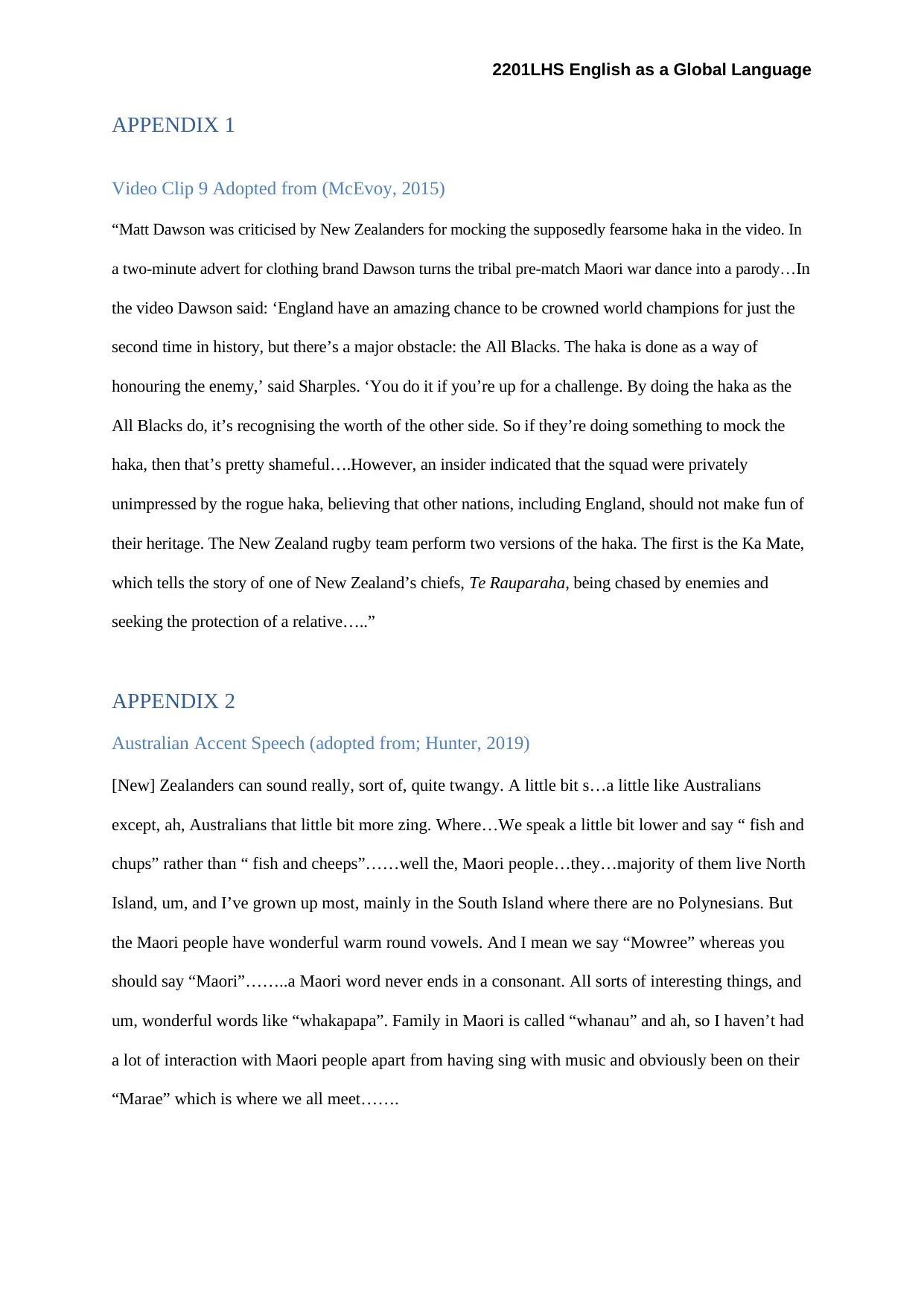
2201LHS English as a Global Language
APPENDIX 1
Video Clip 9 Adopted from (McEvoy, 2015)
“Matt Dawson was criticised by New Zealanders for mocking the supposedly fearsome haka in the video. In
a two-minute advert for clothing brand Dawson turns the tribal pre-match Maori war dance into a parody…In
the video Dawson said: ‘England have an amazing chance to be crowned world champions for just the
second time in history, but there’s a major obstacle: the All Blacks. The haka is done as a way of
honouring the enemy,’ said Sharples. ‘You do it if you’re up for a challenge. By doing the haka as the
All Blacks do, it’s recognising the worth of the other side. So if they’re doing something to mock the
haka, then that’s pretty shameful….However, an insider indicated that the squad were privately
unimpressed by the rogue haka, believing that other nations, including England, should not make fun of
their heritage. The New Zealand rugby team perform two versions of the haka. The first is the Ka Mate,
which tells the story of one of New Zealand’s chiefs, Te Rauparaha, being chased by enemies and
seeking the protection of a relative…..”
APPENDIX 2
Australian Accent Speech (adopted from; Hunter, 2019)
[New] Zealanders can sound really, sort of, quite twangy. A little bit s…a little like Australians
except, ah, Australians that little bit more zing. Where…We speak a little bit lower and say “ fish and
chups” rather than “ fish and cheeps”……well the, Maori people…they…majority of them live North
Island, um, and I’ve grown up most, mainly in the South Island where there are no Polynesians. But
the Maori people have wonderful warm round vowels. And I mean we say “Mowree” whereas you
should say “Maori”……..a Maori word never ends in a consonant. All sorts of interesting things, and
um, wonderful words like “whakapapa”. Family in Maori is called “whanau” and ah, so I haven’t had
a lot of interaction with Maori people apart from having sing with music and obviously been on their
“Marae” which is where we all meet…….
APPENDIX 1
Video Clip 9 Adopted from (McEvoy, 2015)
“Matt Dawson was criticised by New Zealanders for mocking the supposedly fearsome haka in the video. In
a two-minute advert for clothing brand Dawson turns the tribal pre-match Maori war dance into a parody…In
the video Dawson said: ‘England have an amazing chance to be crowned world champions for just the
second time in history, but there’s a major obstacle: the All Blacks. The haka is done as a way of
honouring the enemy,’ said Sharples. ‘You do it if you’re up for a challenge. By doing the haka as the
All Blacks do, it’s recognising the worth of the other side. So if they’re doing something to mock the
haka, then that’s pretty shameful….However, an insider indicated that the squad were privately
unimpressed by the rogue haka, believing that other nations, including England, should not make fun of
their heritage. The New Zealand rugby team perform two versions of the haka. The first is the Ka Mate,
which tells the story of one of New Zealand’s chiefs, Te Rauparaha, being chased by enemies and
seeking the protection of a relative…..”
APPENDIX 2
Australian Accent Speech (adopted from; Hunter, 2019)
[New] Zealanders can sound really, sort of, quite twangy. A little bit s…a little like Australians
except, ah, Australians that little bit more zing. Where…We speak a little bit lower and say “ fish and
chups” rather than “ fish and cheeps”……well the, Maori people…they…majority of them live North
Island, um, and I’ve grown up most, mainly in the South Island where there are no Polynesians. But
the Maori people have wonderful warm round vowels. And I mean we say “Mowree” whereas you
should say “Maori”……..a Maori word never ends in a consonant. All sorts of interesting things, and
um, wonderful words like “whakapapa”. Family in Maori is called “whanau” and ah, so I haven’t had
a lot of interaction with Maori people apart from having sing with music and obviously been on their
“Marae” which is where we all meet…….
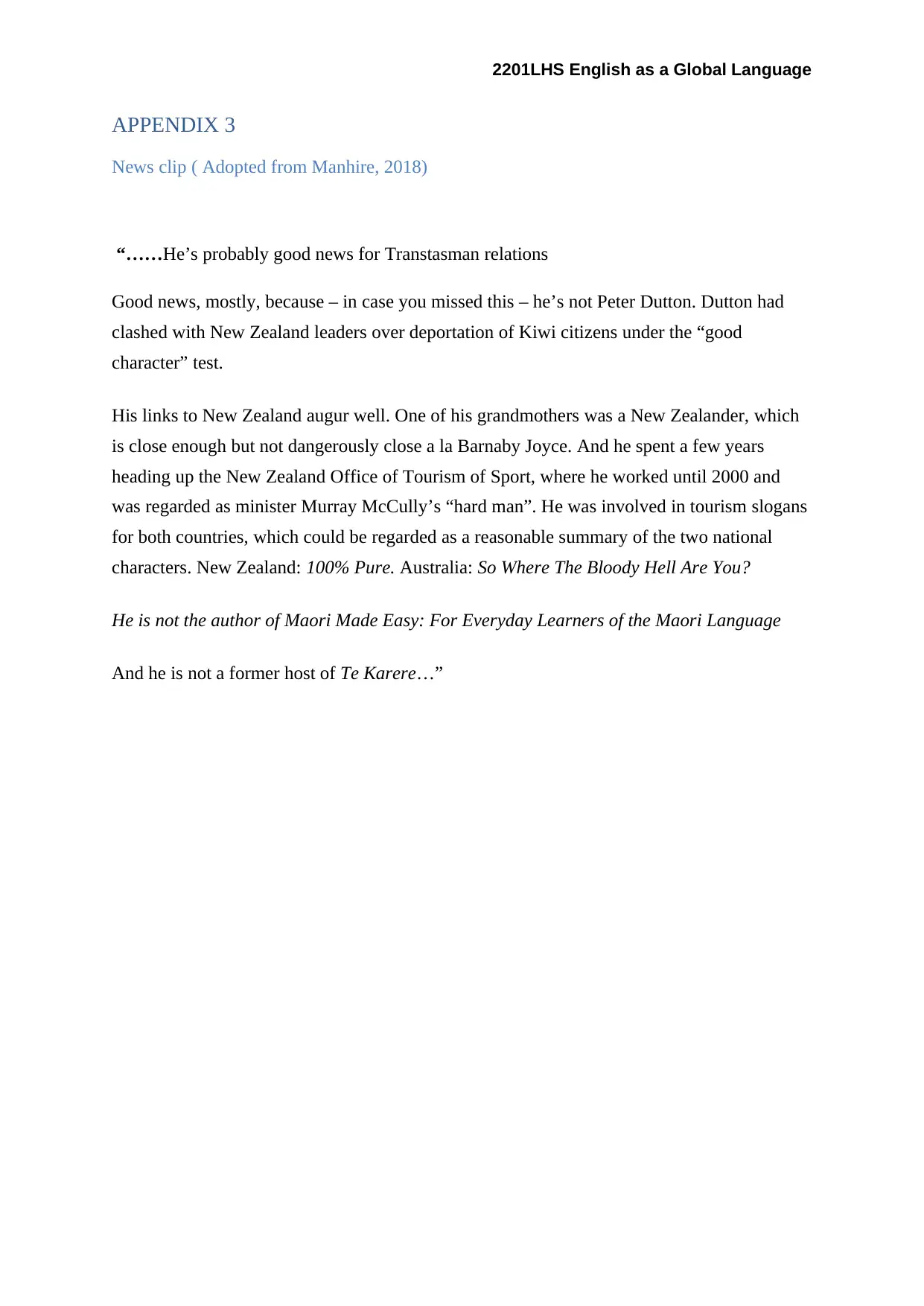
2201LHS English as a Global Language
APPENDIX 3
News clip ( Adopted from Manhire, 2018)
“……He’s probably good news for Transtasman relations
Good news, mostly, because – in case you missed this – he’s not Peter Dutton. Dutton had
clashed with New Zealand leaders over deportation of Kiwi citizens under the “good
character” test.
His links to New Zealand augur well. One of his grandmothers was a New Zealander, which
is close enough but not dangerously close a la Barnaby Joyce. And he spent a few years
heading up the New Zealand Office of Tourism of Sport, where he worked until 2000 and
was regarded as minister Murray McCully’s “hard man”. He was involved in tourism slogans
for both countries, which could be regarded as a reasonable summary of the two national
characters. New Zealand: 100% Pure. Australia: So Where The Bloody Hell Are You?
He is not the author of Maori Made Easy: For Everyday Learners of the Maori Language
And he is not a former host of Te Karere…”
APPENDIX 3
News clip ( Adopted from Manhire, 2018)
“……He’s probably good news for Transtasman relations
Good news, mostly, because – in case you missed this – he’s not Peter Dutton. Dutton had
clashed with New Zealand leaders over deportation of Kiwi citizens under the “good
character” test.
His links to New Zealand augur well. One of his grandmothers was a New Zealander, which
is close enough but not dangerously close a la Barnaby Joyce. And he spent a few years
heading up the New Zealand Office of Tourism of Sport, where he worked until 2000 and
was regarded as minister Murray McCully’s “hard man”. He was involved in tourism slogans
for both countries, which could be regarded as a reasonable summary of the two national
characters. New Zealand: 100% Pure. Australia: So Where The Bloody Hell Are You?
He is not the author of Maori Made Easy: For Everyday Learners of the Maori Language
And he is not a former host of Te Karere…”
⊘ This is a preview!⊘
Do you want full access?
Subscribe today to unlock all pages.

Trusted by 1+ million students worldwide
1 out of 14
Your All-in-One AI-Powered Toolkit for Academic Success.
+13062052269
info@desklib.com
Available 24*7 on WhatsApp / Email
![[object Object]](/_next/static/media/star-bottom.7253800d.svg)
Unlock your academic potential
Copyright © 2020–2025 A2Z Services. All Rights Reserved. Developed and managed by ZUCOL.
